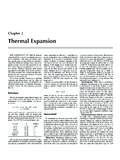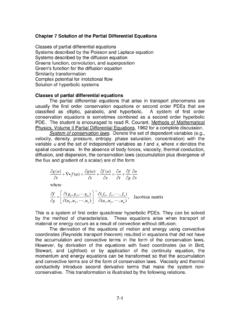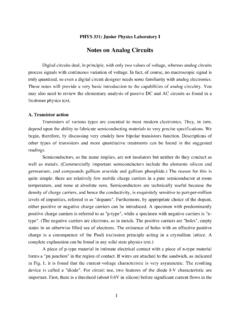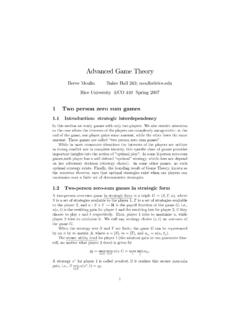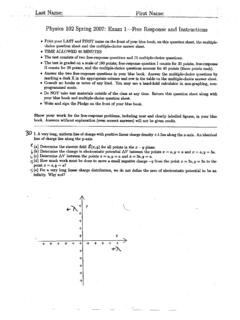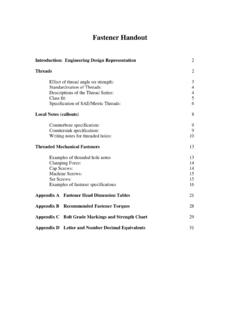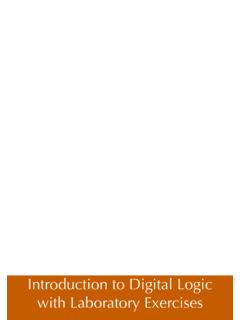Transcription of MECH 401 Machine Design - Rice University
1 mech 401 Mechanical Design ApplicationsMaster Notes of Dr. Marcia K. O MalleySpring 2008Dr. D. M. McStravickRice UniversityCourse Information Meeting time T-Th 8:00 9:15 DH 1064 Prerequisites mech 311 or CIVI 300 Texts Mechanical Engineering Design by Budynas & Nisbett (8thedition) Goals Provide Design skills to support mech 407/408 projects Understand the application of engineering analysis to common Machine elements Enhance your ability to solve practical Design problems using free body diagrams, Mohr s circle, beam analysis, etc. D. M. McStravick, PhD, MEB 224 Phone: est. 2427 Office hours: Wednesday 10:30 -11:30 PM Monday 10:30 11:30 AMSyllabus General policies (25%) Homework Late homework is not accepted Neatness counts! (5%) In-class Quiz on Stress Analysis (25%) In-class Fundamentals Test (25%) In-class Applications Test (20%) ProjectBackground Comments My Background Practical experience in Design mech 401 Defining course for mech Major Tools to make your dreams into a reality EXPERT WITNESSING All from this course TEXT If I could have only one referencebook.
2 Overview and introduction of Design of Machine elements Two primary phases of design1 Inventive phase creative aspect2 Engineering phase understanding of physical reality aspect 1makes a Design unique or clever ( mech 407/408) 2makes a Design work This course will focus on 2ndaspect, making our designs work Understanding of physical reality Theoretical results Empirical results Theory helps us understand physical phenomena so that we can address Design at a fundamental level Theory often falls short, however, in describing complex phenomena, so we must use empirical resultsMethodology Solving Machine component problems Step 1 Define/understand Step 2 Define/synthesize the structure ID interactions Draw diagrams (as a sketch) Step 3 Analyze/solve using: Appropriate assumptions Physical laws Relationships Rules Step 4 Check is the answer reasonable?Homework format Start each problem on a new page One side of sheet only Use straight-edge, work neatly Known: Problem statement Schematic Given data Material properties Find: Concisely state what is to be determined Solution: Assumptions Design decisions Equations (make number substitutions last) Comments (when appropriate)Video -- ENGINEERING DISASTERS Modern Marvels ProgramSystems of Units Appendix lists units (English, SI), conversion factors, and abbreviations Unit A specified amount of a physical quantity by which through comparison another quantity of the same kind is measured Examples?
3 Length, time, temperature 2 basic systems of units customary foot-pound-second system (fps) International System of Units (SI)Primary Quantities Sufficient to conceive of and measure other dimensions Examples? Mass Length Time .. [what/where are the touchstones]Secondary dimensions Measured in terms of primary dimensions Examples? Area Density Velocity Viscosity ..SI System of Units (mLt) Mass, length, and time m kg L m t s F is secondary/derived unit F is in Newtons: 1 N ~ 1 apple (**) F is defined a la Newton s 3rdlaw F = ma 1 N = 1 kg Customary Foot-pound (f)-second (fps) Inch-pound-second (ips) Not a consistent system of units (Why?) fps: Force pound-force (Derived from a pound mass) 1000 lbf = 1 kilopound = 1 kip For a consistent US customary system use 3rdlaw Derived unit of mass is lbf-s2/ft (slug)Statistical Considerations Dealing with uncertainty In engineering nothing is exact (tolerances)Introduction to reliability engineering We cannot assume that all the quantities that we utilize in failure analysis are deterministic quantities We know their values absolutely!
4 In many cases, especially in manufacturing, this is NOT the case A part dimension that is supposed to be 1 in diameter might vary between and inches due to variation in machining process (tool wear) Statistics and random variable methods enable designers to deal with variable quantities Reliability EngineeringDefinitions Random (stochastic) variable A real-valued set of numbers that result from a random process or are descriptive of a random relationship For example, if I were to construct a list of everybody s height in this Then height, H, would be considered a random variableSample #H (height in inches)1234 Height example Let s say there are 25 people in this class. Construct a histogram to represent the data If we divide the (# of people) axis by the total number of people sampled, then we have Probability density function (PFD) PDF gives the probabilitythat a random variable will have a certain value Same shape as the histogram (it s been normalized N)Height example If we integrate this function , we get the cumulative distribution function (cdf) Gives the probability (likelihood) that a random variable will be less than or equal to a given value For a random variable x, For a discrete random variable,1)(lim= xFx() =ijxxjixfxF)(()ixFCharacterizing random variables A random variable is not a scalar, but rather a vector In this deterministic case, we can say x = inches This is a scalar, since it has only a single value In the stochastic case, we know that the variable x can take on many values x = , , , etc We define the discrete random variable xto be a vector of the samples x1, x2.
5 , xn We refer to xas the variate Note, in this sense, a vector can be considered a collection of numbers, not a quantity with direction and magnitude It is helpful to have some scalar quantities that characterize the random variable vector Direction and magnitude won t do the trick! = quantities to characterize x Mean A measure of the central value of a distribution Standard deviation A measure of the dispersion or distribution of data Note this is most useful as a comparative measure By itself, it s not particularly useful! Some people use 1/N instead of 1/(N-1), but 1/(N-1) typically gives better results for small N The notation for mean and standard deviation of a variate are as follows:()2112 11 =NiixN () , =x ==+++ Example of Mean and Standard Deviation Example 20-1 p. 963 Example 20-2 p. 964 Reliability Engineering, Cont. Terminology Population The total set of elements in which we are interested Sample A randomly selected subset of the total population on which measurements are taken (class vs.)
6 US Population) Describing the shape of a distribution Uniform Normal Log Normal WeibullWe ll look at theseUniform distribution Simplest All elements have the same value Area equal to 1 implies that all samples in the given range of x have the same value of f(x), where f(x) describes the distributionNormal distribution Also called Gaussian distribution Small standard deviation ( )^Large standard deviation ( )^ =2 212 1)( xexfNotation Normal distribution with mean and standard deviation: This IS a complete characterization CDF of Normal (Gaussian) Distribution cannot be found in closed form [Use table A -10; Example 20-3 ] Generalized description of normal CDF: Note: () , Nx= =xZduufxFx =)()(Linear Regression Obtaining a best-fit to a set of data points Linear regression when best fit is a straight line Correlation coefficient tells you how good the fit isLinear Regression Equations Equation of a line y = mx + bError equation for a pointyi = mi + b + eiSolving for ei^2 and minimizing ei^2 gives eqns.
7 In m & bAllows solving for m and b of the linear regression lineiiibmxy ++=iiibmxy ++=iiibmxy ++=iiibmxy ++=iiibmxy ++=iiibmxy ++=How good is the fit to the data?Use a correlation coefficient rr=m^ sx/syr is between -1-+1+1 or -1 is perfect correlationm^ is the linear regression slopeSx is the standard deviation of the x coordinatesSy is the standard deviation of the y coordinatesMaterials Must always make things out of materials Must be able to manufacture this thing Topics first introduced in Materials Science course (MSCI 301) How do we determine the properties of a material? Tables How were these values determined? Generally via destructive testingMaterial properties Listed in tables Statistical variation Values listed are minimums Best data from testing of prototypesunder intended loading conditionsMaterial parameters Parameters of interest in material selection for Design ? Strength Stiffness Weight Toughness Conductivity Thermal Corrosion resistancePRIMARY CONCERNSP rimary parameters of interest in material selection Strength Amount of load (or weight, or force) a part can take before breaking or bending Stiffness Amount of deflection or deformation for a given load Weight All of these depend on geometry EXTENSIVE values We would like to derive results that are independent of size (geometry) INTENSIVE valuesExtensive vs.
8 Intensive values Extensive Weight (kg) Strength (N) Stiffness (N/m) Intensive Density (kg/m3) Yield strength or Ultimate Strength (N/m2) Modulus of Elasticity (N/m2)How do we determine these values? Types of quasistatic material testing Tension Compression Bending TorsionTensile tests specimensMild ductile steel tensile test specimenBrittle cast iron tensile test specimenWhat is the difference between these specimens?Tensile testing Best for general case Why? Uniform loading and uniform cross-section generate uniform stress Compression poses stability problems (buckling) Torsion and bending impose non-uniform stressOther test specimens Ductile and BrittleCompressionBendingTorsionStress-S train ( - ) Curves Point A Proportional limit Point B Elastic limit Point C Yield point Usually defined by permanent set of = ( offset) For purposes of Design , we often assume A~B~C, and call this the yield point Slope of O-A = E Young s Modulus Modulus of elasticity Like stiffness Point F Onset of failure Point G, G - FractureG true (accounting for A) OABCG measured (F vs.)
9 X)FE Important Design considerations Sy= Yield strength It is the stress That will result in permanent set At which material undergoes marked decrease in stiffness At which Hooke s Law is no longer valid Su= Ultimate strength Stress level that will result in fracture OA, B, CFE SySuDuctile vs. Brittle Material Behavior Ductile material Sustains significant plastic deformation prior to fracture Brittle material No significant plastic deformation before fracture O E Sy Su O E Sy Su Remember the Titanic video -- Temperature issueDuctile vs. Brittle Material Behavior The only true means of determining if a material is ductile or brittle is by testing it (tensile test) Note: The same alloy can be either ductile or brittle, depending upon temperature and/or how it was formed Some general indications of brittle behavior Glass, ceramic, and wood Cast ferrous alloys Materials in extreme cold temperatures Also, if you can t find Sy in a handbook (only Sugiven)Fatigue testing measuring endurance Most machines are loaded cyclically Any piece of rotating machinery Strength decreases over time Fatigue strength depends on number of cycles and the material How to test?
10 Use a rotating beam More often vary axial loading over timeCommon metals in Machine Design Magnesium Specific stiffness ~ 25 MPa/(kg/m3) Extremely light (~1/5 steel) Extremely flammable Aluminum (very common) Specific stiffness ~ 26 Stiffness-to-weight and strength-to-weight comparable to steel 1/3 stiffness of steel 1/3 density of steelMore Gray cast iron Specific stiffness ~ 15 Decent strength Used where casting makes sense and weight doesn t matter Gears, engine blocks, brake disks and drums Brass, bronze Generally soft Good for bearings (bronze)More Titanium Specific stiffness ~ 26 Excellent strength-to-weight Non-magnetic Non-corrosive (implants) Can be cast Expensive Ductile cast iron Stronger than gray cast iron Heavy-duty gears, automobile door hingesMore Stainless steel Non-magnetic Much less corrosive than steel Difficult to Machine Steel Specific stiffness ~ 27 Excellent fatigue properties Good stiffness-to-weight Better alloys have excellent strength-to-weight Chromoly bicycle framesComparison of Young s Modulus for various metalsAlloying and Crystal Does all steel have the same strength?
